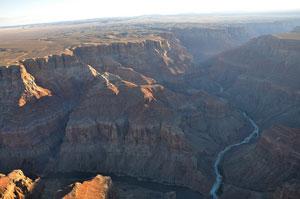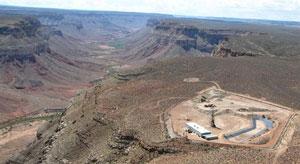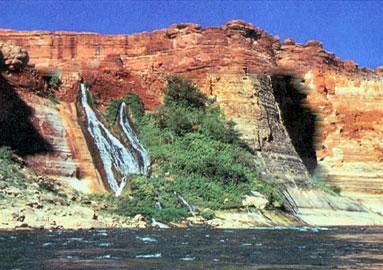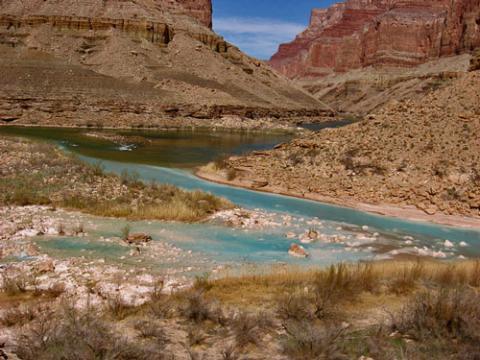In many situations organizations from sports teams to corporations strive to earn the distinction of being named "Number One in the country." That's not the case, however, when it comes to a list of America's Most Endangered Rivers, and the Colorado River in Grand Canyon National Park has unfortunately earned that label on a just-released annual report.
The 2015 version of "America's Most Endangered Rivers®" was been released by the conservation group American Rivers, and it names the Colorado River in the Grand Canyon "the #1 Most Endangered River in the nation."
Describing the Colorado River through the canyon as "one of our country's most iconic stretches of river and an irreplaceable national treasure," the report notes the waterway "faces a battery of threats that could forever harm its health and unique experience that belongs to every American."
Report Identifies "Three Serious Threats" to the River
The organization identifies "three serious threats" facing the river and canyon, "each with a key decision this year: the massive Escalade construction project in the heart of the canyon, pollution from uranium mining on the north and south rims, and expansion of the town of Tusayan that could deplete vital groundwater supplies."

The confluence of the Colorado and Little Colorado Rivers. NPS photo.
"These threats would cause irreparable harm to the river's unique wild character, clean water, and cultural values," the report notes. "American Rivers called on Secretary of the Interior Sally Jewell and the Obama Administration to use every authority to prevent damage to the river and preserve the Grand Canyon for all Americans to enjoy."
"The Biggest Threats in a Generation"
'The Grand Canyon is facing the biggest threats in a generation,' said Bob Irvin, President of American Rivers. 'The Colorado River in the Grand Canyon is an irreplaceable national treasure that should be preserved for all of us, for all time. The Grand Canyon is not for sale.'
The report notes, "One of the Seven Natural Wonders of the World, the Grand Canyon is the traditional homeland of native tribes including the Navajo, Hopi, Havasupai, Hualapai, and Zuni and draws nearly five million visitors every year. Dozens of creeks, springs, and tributaries connect with the Colorado River in the Grand Canyon, including the Little Colorado River, Kanab Creek, Havasu Creek, and Bright Angel Creek."
'The Grand Canyon is the cultural homeland of many traditional people and this project would be a sacrilege to them,' said Roger Clark, Grand Canyon program director at the Grand Canyon Trust. 'We're honored to support Navajo community members opposed to this project as part of the Save the Confluence coalition.'
Grand Canyon Escalade Project Includes Tram to Bottom of the Canyon
According to the document, "The proposed Grand Canyon Escalade project includes a two-million-square-foot development on the canyon rim, a tram delivering up to 10,000 visitors a day to the bottom of the canyon at the confluence of the Colorado and Little Colorado rivers, and riverside walkways, restrooms, a gift shop, and restaurant. The massive amount of construction, noise, and pollution would irreversibly harm the fragile heart of the canyon. The confluence, the site of the project, is a sacred area for native tribes."
'This billion dollar scheme would be a travesty, destroying the very qualities that make the Grand Canyon such a spectacular life-changing experience, and an economic engine for the region,' said Irvin. The Grand Canyon Trust quotes Grand Canyon National Park Superintendent David Uberuaga, who described "the proposed Escalade gondola as one of the most 'serious threats' the park has faced in its 95-year history."
While promoters of the proposed Grand Canyon Escalade project tout its potential economic benefits, other groups, including some residents of the Navajo Nation, agree with the concerns raised by American Rivers. In addition to opposition from some Navajo, the governors of Zuni Pueblo, Acoma Pueblo, Laguna Pueblo and the Hopi Tribe have expressed their unanimous opposition to the Grand Canyon Escalade Project.

The Kanab North mine, north of Grand Canyon National Park. USGS photo by Don Bills.
"In addition to the urgent threat of the Escalade project, existing and proposed uranium mining operations threaten the clean water of tributary streams in the Grand Canyon and the Colorado River," Irvin notes. "And, a major expansion of the town of Tusayan, which lies less than five miles from the south entrance to Grand Canyon National Park, threatens sensitive groundwater supplies."
Major Expansion Envisioned for Town of Tusayan
According to some published reports, the proposed Tusayan development by an Italian corporation would add as many as 2,200 homes to the small town that straddles the main highway leading into the park's South Entrance. The developer's website mentions plans for single-family homes, apartment, condominiums and townhouses, a recreational vehicle park, neighborhood commercial services, a dude ranch and spa hotel. Also in the proposed mix are "a wide range of visitor services" that will include lodging, a pedestrian-oriented retail village, an Insight educational campus, a Native American Cultural Center, and a conference hotel.

Springs such as Vasey's Paradise could be impacted by increased pumping from wells in the area. Photo by R.D. MacNish, USGS.
Chief among the concerns for these major changes is the limited supply of water throughout the area.
"Depleting already-stressed groundwater could impact the seeps and springs that feed the Grand Canyon, threatening the fragile desert environment," Irwin cautions. The park superintendent agrees, asking, 'Why are we considering further development when to this day we're still hauling water into the town of Tusayan for the existing buildings?'
The annual America's Most Endangered Rivers® report is a list of rivers at a crossroads, where key decisions in the coming months will determine the rivers' fates. Over the years, the report has helped spur many successes including the removal of outdated dams, the protection of rivers with Wild and Scenic designations, and the prevention of harmful development and pollution.
'This year's report underscores the importance of healthy rivers to each and every American,' said Irvin. 'Whether it's for clean drinking water, ample water supplies for farms and cities, abundant fish and wildlife, or iconic places vital to our heritage, we all have a stake in protecting our nation's rivers.'
You can read about the other nine rivers included on this year's list of "America's Most Endangered Rivers" at this link.




Add comment